Top Rankings
St. Paul City School District ranks among the top 20% of public school district in Minnesota for:
Category
Attribute
Diversity
Most diverse schools (Top 1%)
For the 2025 school year, there is 1 public preschool serving 299 students in St. Paul City School District. This district's average pre testing ranking is 1/10, which is in the bottom 50% of public pre schools in Minnesota.
Public Preschool in St. Paul City School District have an average math proficiency score of 5% (versus the Minnesota public pre school average of 45%), and reading proficiency score of 12% (versus the 47% statewide average).
Minority enrollment is 99% of the student body (majority Hispanic and Black), which is more than the Minnesota public preschool average of 42% (majority Hispanic and Black).
Overview
This School District
This State (MN)
# Schools
3 Schools
722 Schools
# Students
590 Students
214,815 Students
# Teachers
42 Teachers
16,916 Teachers
Student : Teacher Ratio
14:1
14:1
District Rank
St. Paul City School District, which is ranked within the bottom 50% of all 522 school districts in Minnesota (based off of combined math and reading proficiency testing data) for the 2021-2022 school year.
The school district's graduation rate of 50% has stayed relatively flat over five school years.
Overall District Rank
#517 out of 527 school districts
(Bottom 50%)
(Bottom 50%)
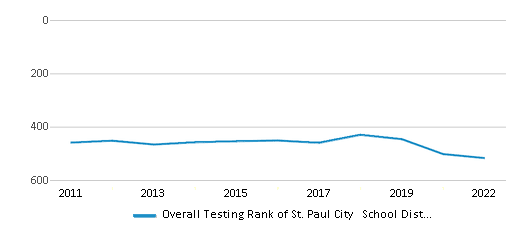
Math Test Scores (% Proficient)
7%
45%
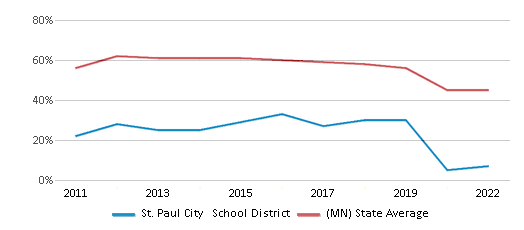
Reading/Language Arts Test Scores (% Proficient)
17%
51%
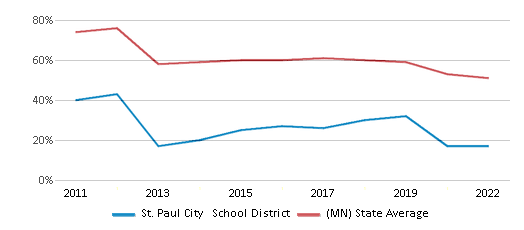
Science Test Scores (% Proficient)
≤5%
41%
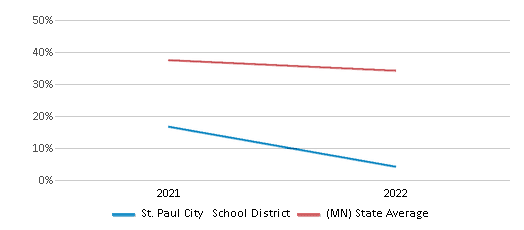
Graduation Rate
<50%
84%
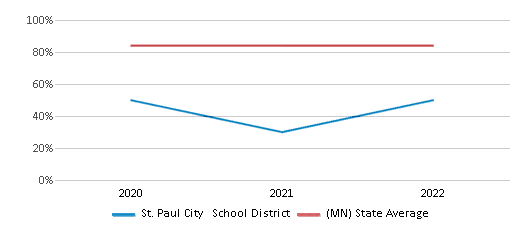
Students by Ethnicity:
Diversity Score
0.68
0.63
# American Indian Students
6 Students
4,606 Students
% American Indian Students
1%
2%
# Asian Students
105 Students
15,449 Students
% Asian Students
18%
7%
# Hispanic Students
279 Students
28,913 Students
% Hispanic Students
47%
13%
# Black Students
150 Students
27,236 Students
% Black Students
26%
13%
# White Students
14 Students
123,893 Students
% White Students
2%
58%
# Hawaiian Students
n/a
300 Students
% Hawaiian Students
n/a
n/a
# Two or more races Students
36 Students
14,418 Students
% of Two or more races Students
6%
7%
Students by Grade:
# Students in PK Grade:
35
24,443
# Students in K Grade:
50
34,761
# Students in 1st Grade:
33
32,541
# Students in 2nd Grade:
45
32,166
# Students in 3rd Grade:
46
29,034
# Students in 4th Grade:
47
28,343
# Students in 5th Grade:
43
24,163
# Students in 6th Grade:
49
7,122
# Students in 7th Grade:
47
1,002
# Students in 8th Grade:
45
940
# Students in 9th Grade:
49
44
# Students in 10th Grade:
40
46
# Students in 11th Grade:
41
48
# Students in 12th Grade:
20
162
# Ungraded Students:
-
-
District Revenue and Spending
The revenue/student of $15,985 in this school district is less than the state median of $17,854. The school district revenue/student has declined by 12% over four school years.
The school district's spending/student of $14,656 is less than the state median of $18,580. The school district spending/student has declined by 12% over four school years.
Total Revenue
$9 MM
$15,547 MM
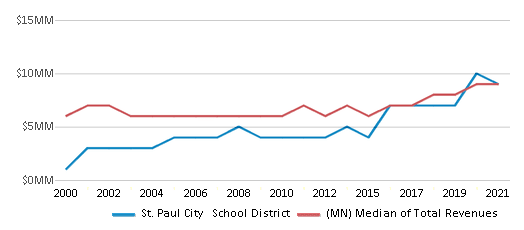
Spending
$9 MM
$16,179 MM
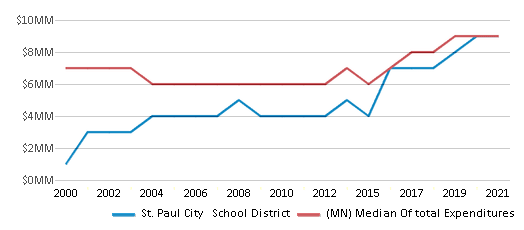
Revenue / Student
$15,985
$17,854

Spending / Student
$14,656
$18,580
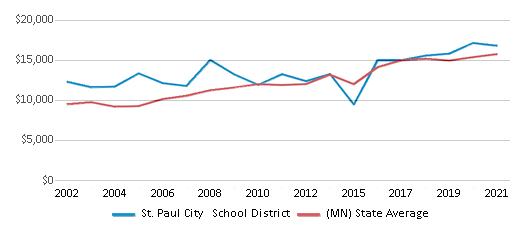
Best St. Paul City School District Public Preschools (2025)
School
(Math and Reading Proficiency)
(Math and Reading Proficiency)
Location
Grades
Students
Rank: #11.
St. Paul City Primary School
Charter School
(Math: ≤5% | Reading: 10-14%)
Rank:
Rank:
1/
Bottom 50%10
215 University Ave W
Saint Paul, MN 55103
(651) 225-9177
Saint Paul, MN 55103
(651) 225-9177
Grades: PK-5
| 299 students
Recent Articles

Year-Round Or Traditional Schedule?
Which is more appropriate for your child? A year-round attendance schedule or traditional schedule? We look at the pros and cons.

Why You Should Encourage Your Child to Join a Sports Team
Participating in team sports has a great many benefits for children, there is no doubt. In this article you will learn what those benefits are.

White Students are Now the Minority in U.S. 九游体育s
Increasing birth rates among immigrant families from Asia and Central and South America, combined with lower birth rates among white families, means that for the first time in history, public school students in the United States are majority-minority. This shift in demographics poses difficulties for schools as they work to accommodate children of varying language abilities and socio-economic backgrounds.





